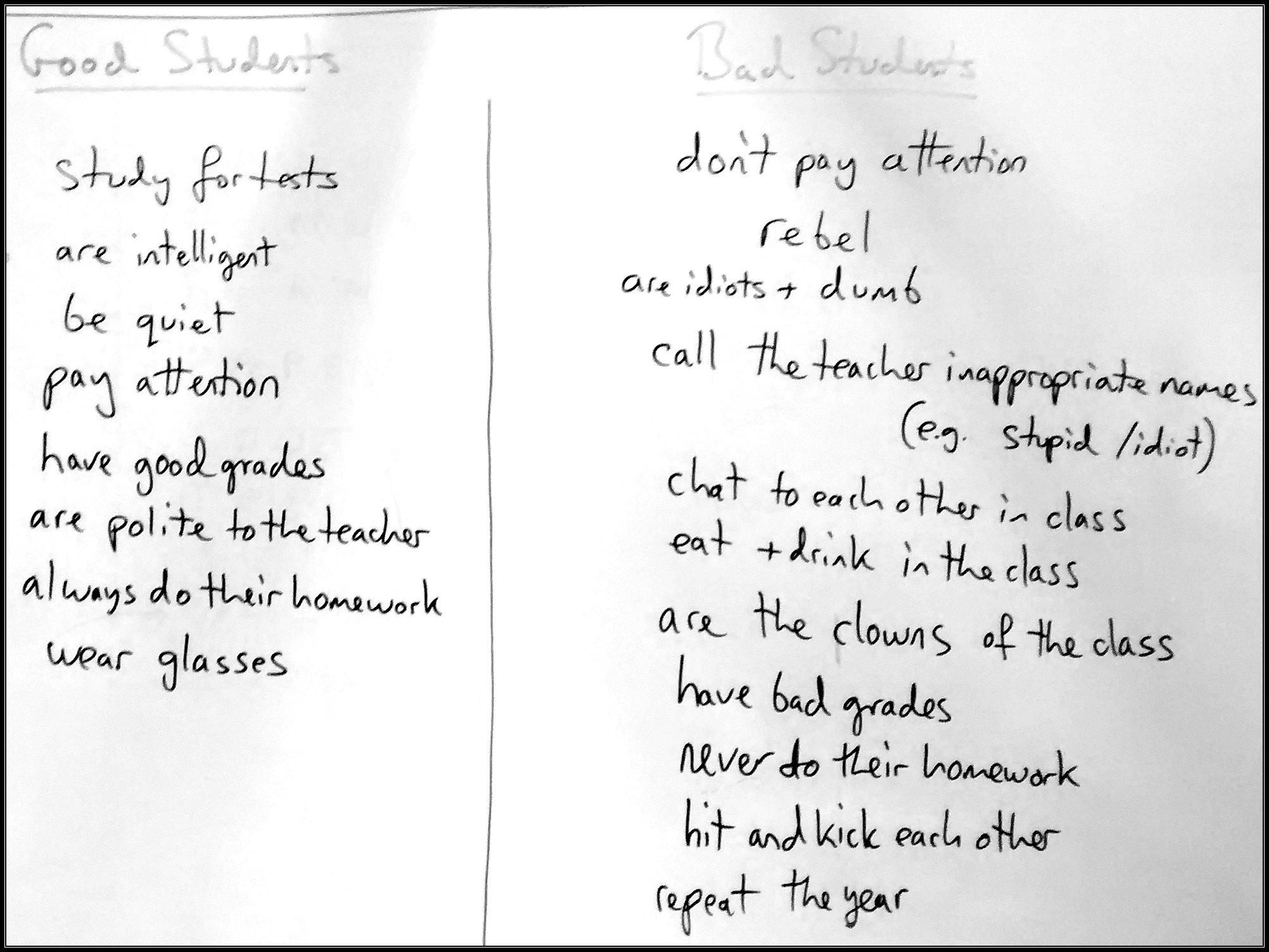
teflgeek
Not so long ago I found out that two of my teenage students have been having a competition in my classes. Apparently they’ve been trying to see who can say the word “genitais” the most in class - this means “genitals” in English. They’ve been doing this for the last three months and it only came to light because they clearly got bored of my inability to notice and asked me if I knew what it meant.
Not, I’m sure you will agree, the behaviour of a good student.
But then what is?
The topic came up again with another class today, as part of a discussion on good study skills, so I asked them for their thoughts on what makes a good or bad student. Now this group is younger, they’re about 13 years old, which accounts for some of the content, and I reformulated one or two suggestions (though I was impressed when they came up with “the class clowns”).

In asking young learners what makes a good or bad student, you are always going to get a degree of polarisation and counter point. If the good student “always does their homework” then it stands to reason that the bad student “never does their homework”. Nonetheless three things immediately jump out at me:
- The utter negativity of the bad student.
- The impossibility of being a good student.
- The complete lack of a middle ground.
(1) The utter negativity of the bad student.
Bad students here are demonized. Look at that word “rebel” in there! It’s so true as well - if you set yourself against the system in any way, you get crushed by the teacher or at the very least you are cast in the role of the villain for the rest of the school year. The problem is that, if as the teacher, you cast one of your students in that role, you aren’t giving them any other role to perform - what else are they expected to do? Don’t challenge authority kids - even when it’s wrong - because that way lies destruction!
There’s the social stigmatism there as well, “are idiots and are dumb” - if we can’t control our students ourselves, then let us, as teachers, set the children against each other and let them do the dirty work for us. We are civilized, we are emotionally in control and we don’t stoop to name calling. But we all know why the bad students are bad students - they just aren’t as intelligent as us. It’s got nothing to do with the background of the “bad” student, it doesn’t matter that they’re being bullied in the playground and are acting out because of it. Bad behaviour is not seen as a sign of emotional need - it is seen as a sign of poor intelligence.
And there’s the performance angle. Bad students get bad grades. Yes, that’s right, the fault is with the student. They are the one who failed to understand. They are the one who couldn’t answer the question. They are the one who had a bad day when it was test time and therefore they are at fault. The failure of a student to understand is not the fault of the student, it is a failure of instruction. I should point out that I fail at instruction all the time. I fail at even giving instructions all the time - I see the sideways glances and hear the whispered conversations and every now and again get the question “Teacher, what is to do?” Equally, I’m not suggesting that it is always the failure of the teacher - most of the time it is the failure of the situation surrounding the teacher - if you have a class of 30 students and you are busy dealing with three of them, you might not notice the quiet one struggling in the corner. Or you might not realise the student who has taken his trousers down in the classroom is doing all this attention seeking behaviour precisely to divert attention away from the fact that they don’t have a clue what is going on. But if we continue to decide whether students are good or bad based on their grades, how can we ever hope that our students place a value on things other than performance? When will our students ever see each other as human beings?
(2) The impossibility of being a good student.
Ok. The whole “wear glasses” thing was suggested by one of the students who just happens to wear glasses. And so do I, so I wasn’t going to disagree…..
But let’s look at what else is there: are quiet, pay attention, have good grades, are polite to the teacher, always do their homework, are intelligent (for a given value of intelligent, which I suspect would probably correlate strongly with “get good grades”). Once we’d got all this on the board I asked them how many of them thought they were good students. Actually I had asked them this before we started listing criteria and without exception, they started putting their hands up and saying “Teacher, I got 82% in history!”, “I have 90 in English.” It was this that started our little digression into what makes a good student as when I asked them if that was the only thing that meant they were good students, some of the other criteria started emerging.
When I asked them again though, about three of them put their hands up. The others said they didn’t always get good grades, or they weren’t always quiet, or they didn’t think they were very intelligent (how my heart goes out to them there!!!!), or they missed a couple of homework tasks. So that works out at about 25% of the class.
25%.
Only 25% of my class think they are good students.
How messed up is a system where 75% of the students think they are automatic failures? Where, by their own description, they are idiots?
Like most teachers, I would love to have a class full of polite, quiet, focused and attentive students who always did what I said and did the work. What I have in most cases is a group of students who can occasionally be persuaded to do some work, but who would really prefer to be playing games of some kind. I think the question from the teacher’s perspective is what do you expect? Should I expect my students to be “good” all of the time? It’s not like we get that all the time in the real world - just take a drive through the centre of your town at rush hour and see if I’m wrong! If we continue to set our expectations so high, if we expect our students, regardless of age, to behave as though they were us, then both we and they are doomed to failure and the class is doomed to a year of demotivated learning punctuated by tantrums.
The good student doesn’t exist. The good student is a mythical ideal generated largely for the benefit of teachers so that students, kids who crave praise and the external validation of the authority figure, know what exacting standards must be achieved and will strive to get that validation. The myth of the good student tells students that what their teachers really want - is to be left alone.
(3) The lack of a middle ground
The discourse surrounding student identity is completely polarised. Students, it seems, are either one thing or the other and see themselves in those terms. You are either for or against, good or bad, successful or a failure. There is a moral absolutism inherent in this view of classroom management that simply does not reflect the reality of the situation. It requires the observer (teacher or otherwise) to make a value judgement about the nature of an individual based on subjective interpretation of behaviour - according to standards that as I’ve already said, are unobtainable.
Most societies, even those that spring from more dogmatic perspectives, embrace a degree of relativism in their social and cultural attitudes. So why is there no middle ground in this?
What disturbed me most about the conversation with my class is that even at the age of 13, they have been brainwashed into this view that they are either good or they are bad. I know that more nuanced views develop with age, but the fact that students don’t see that they can contain elements of both is troubling. At any given moment, in any given classroom, an otherwise great student has let their mind float off somewhere. This is not a bad thing.
I tried to encapsulate this in a diagram - the idea is that at any moment in a lesson, students can place themselves somewhere within the diagram.

It’s not perfect and would probably be better as a series of bar charts. The positives are lumped together mostly because they tend to go together. If you’re in the right frame of mind to start with, then the rest comes easier. And so forth and vice versa. But it serves to visualise the series of dichotomies that students are up against.
Most students would probably put themselves somewhere in the top half of the circle. Some in the middle and maybe a few in the lower half. But very few would place themselves at the extremes and this is because by and large, we all occupy the middle ground. We are rarely completely one thing or the other and if we only see ourselves in these polarised terms, then we run the risk of perpetual failure or stressed out over-achievement. More to the point, as teachers, if we only ever expect brilliance and good behaviour from our students, we are dooming them to failure before they even start. If you can’t be brilliant, you might as well not even try. That’s the message it sends and we end up, inadvertently, teaching our students to be intolerant of anything less than perfection.
We are all individuals and we are all different (or at least most of us are). As adults we accept each others’ imperfections with relative good grace and we don’t define ourselves with arbitrary labels like good and bad because we accept that we all have strengths and weaknesses, different backgrounds and different interests. We come together in the middle ground to work together, study together, socialize and start relationships. Perhaps finding and occupying that middle ground is what we should also be doing in the classroom.
I think the last word in this should go to Joao, who asked me a question towards the end of the lesson:
“Teacher, am I the class clown?”
“What do you think?”
“I think maybe yes.”
“OK. Why do you think that?”
“Because I’m not quiet and I play a lot and make jokes.”
“Is that a bad thing?”
“Maybe yes.”
“Why?”
“Because then I can’t get good grades.”
“Well, if you can be the class clown and get good grades, then it’s not a problem.”
“Hmm. Teacher I don’t want be bad student.”
“I don’t think you’re a bad student.”
“I try to be good student.”
Link nội dung: https://mozart.edu.vn/good-student-arent-a49713.html